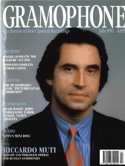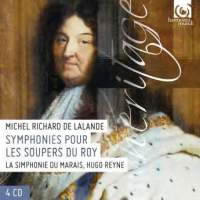Texte paru dans: / Appeared in: |
|
|
Outil de traduction (Très approximatif) |
|
|
Reviewer: Nicholas Anderson
I first got to know and love a selection of Delalande's Sinfonies pour les soupers du Roi through recordings issued by L'Oiseau-Lyre in the 1950s under Pierre Colombo and Louis de Froment. It was a happy and generous thought of Hugo Reyne, the director of this new four-disc set, to pay tribute to these and other pioneers in the opening paragraph of his useful essay. As I remarked in July last year, when reviewing Edward Higginboltom's Erato disc of grand motets by Delalande, this gifted composer is, in France at least , beginning to receive once more the attention due to him. During the 1950s several recordings of his music were issued , mainly by Erato and L'Oiseau-Lyre. Since then , however, most especially in the last decade, he has been unfairly eclipsed by the astonishing but justified burst of enthusiasm for his slightly older contemporary and compatriot Charpentier.
As if making up for this lost time Harmonia Mundi boldly have released not merely an anthology of Delalande's Sinfonies but the whole lot, including the three beautiful Caprices, the second of which , in G minor, contains some of the composer's most alluring instrumental music. The King frequently asked for it, so the manuscript tells us, and it is not hard to understand why. The most important source of this vast collection of pieces is the Philidor manuscript assembled in 1703 but with additions made shortly before Louis XIV's death (1715). A second, larger and handsome copy was put together in 1745 but, though based on the Philidor manuscript and another interim one, its second volume also contains music by other composers, too. The recording is based on the Philidor version with its additions.
Confronted with some 158 items whose average duration is probably in the region of one and a half minutes this is manifestly not intended for sustained listening. Best by far to take a suite at a time for there are five hours of music contained here. Some of the pieces are, perhaps inevitably, run-of-the-mill but they are the minority and listeners will frequently be beguiled by Delalande's feeling for dance measures and even more perhaps by the non-dance orientated movements. These latter occur above all in the Caprices where the composer emerges not only as a skilful harmonist but as one capable of profoundly affecting the senses. Delalande's feeling for instrumental colour is often striking as, for instance in the second Caprice or Fantaisie which is scored for violins, violas, bassoons and continuo. The first Caprice, on the other hand is resplendently scored for trumpets, timpani, woodwind and strings; the opening dotted measures of its overture, incidentally , recall those of Bach's Orchestral Suite No . 3 in D major.
Very often, though, the composer does not give precise information about scoring and the decision is of necessity left to the performer. Reyne has given careful thought to these matters though I occasionally found myself in disagreement with him. Castanets and xylophone, infrequent though their appearances are , take a bit of getting used to and I did not feel that they added any important dimension to music which manages to stand well without them. But they are of little significance in the context of so much else that is sympathetically interpreted. Sometimes the playing lacks finesse but it does not lack esprit and the music is generally conveyed with affection and a good sense of style.
To sum up, this is an attractive
issue and one which should be of great interest to all lovers of baroque music.
The wide variety of pieces will accommodate most tastes , whether at the dinner
table or elsewhere; indeed, the bizarre "Sinfonie du Marais" would seem more
appropriate to the bathroom . The Caprices, above all, though , will afford
lasting pleasure . |
|
|
|
|
|
Cliquez l'un ou l'autre
bouton pour découvrir bien d'autres critiques de CD |
|




